Theories and Cultural Factors Shaping Child Personality: An Essay
VerifiedAdded on 2022/11/02
|11
|3320
|454
Essay
AI Summary
This essay provides a comprehensive analysis of the factors that contribute to the development of a child's personality. It begins by highlighting the shift in understanding from hereditary influences to the combined impact of heredity and environment, particularly the role of parenting. The essay then delves into the influence of cultural factors on personality, examining how language, societal norms, and socialization processes shape children's beliefs and behaviors. It further explores Bowlby's attachment theory, discussing how early attachment patterns influence personality traits and the potential for anxious or avoidant attachment styles. Finally, the essay examines Piaget's theory of cognitive development, outlining the stages of cognitive growth and how they impact a child's understanding of the world and their ability to reason. The essay emphasizes the dynamic and interactive nature of child personality development, incorporating insights from diverse perspectives within the field of psychology to provide a well-rounded understanding of the topic.
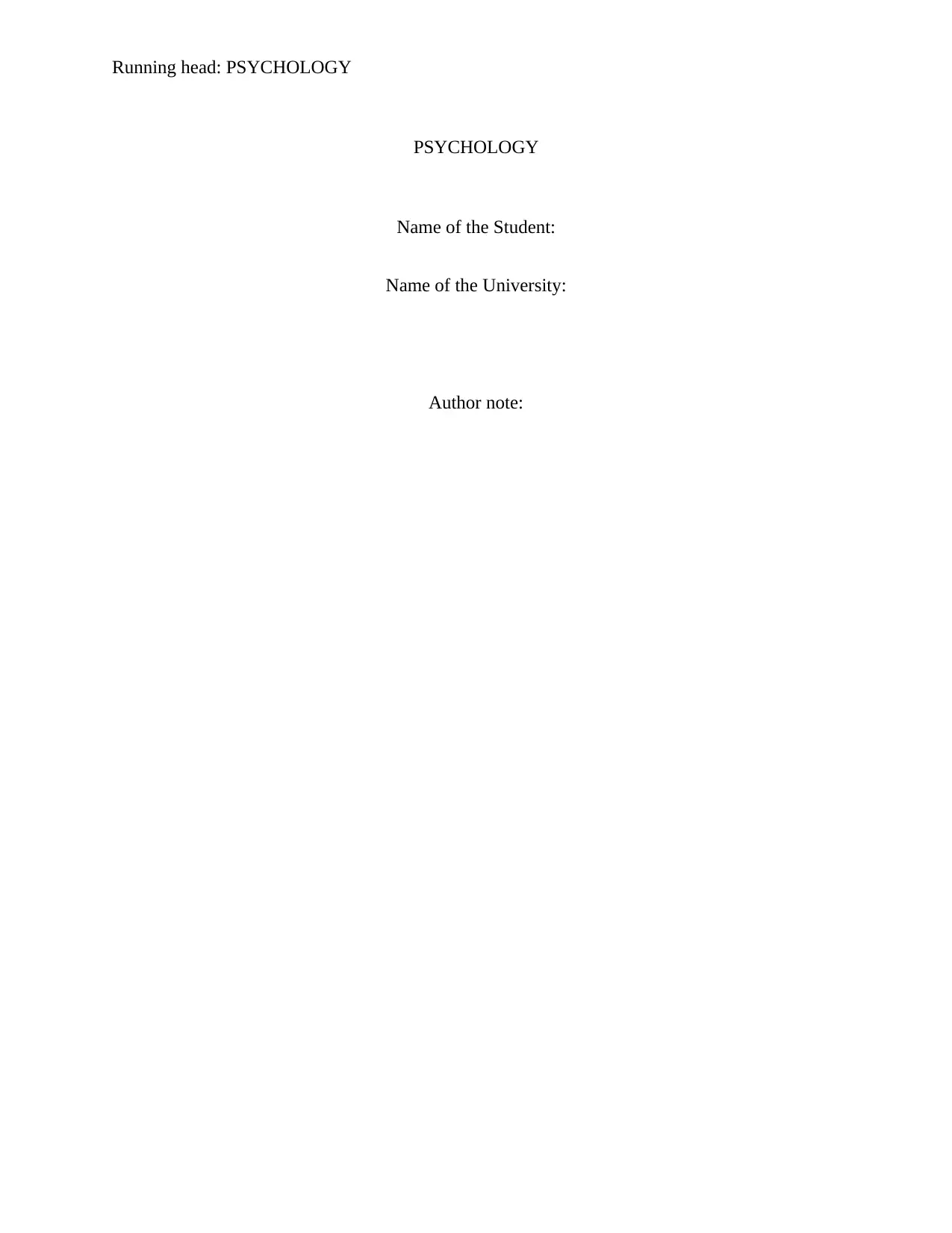
Running head: PSYCHOLOGY
PSYCHOLOGY
Name of the Student:
Name of the University:
Author note:
PSYCHOLOGY
Name of the Student:
Name of the University:
Author note:
Paraphrase This Document
Need a fresh take? Get an instant paraphrase of this document with our AI Paraphraser
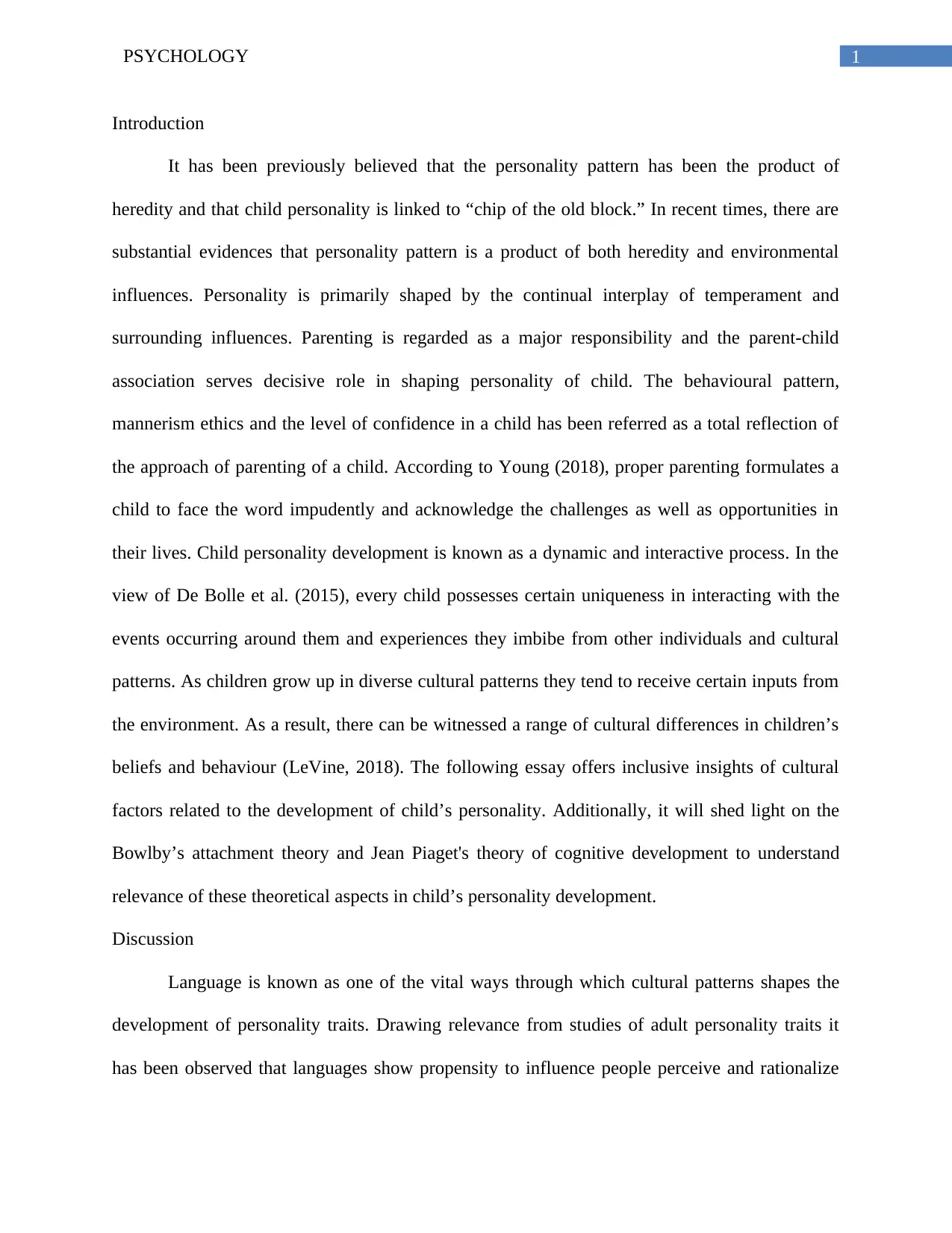
1PSYCHOLOGY
Introduction
It has been previously believed that the personality pattern has been the product of
heredity and that child personality is linked to “chip of the old block.” In recent times, there are
substantial evidences that personality pattern is a product of both heredity and environmental
influences. Personality is primarily shaped by the continual interplay of temperament and
surrounding influences. Parenting is regarded as a major responsibility and the parent-child
association serves decisive role in shaping personality of child. The behavioural pattern,
mannerism ethics and the level of confidence in a child has been referred as a total reflection of
the approach of parenting of a child. According to Young (2018), proper parenting formulates a
child to face the word impudently and acknowledge the challenges as well as opportunities in
their lives. Child personality development is known as a dynamic and interactive process. In the
view of De Bolle et al. (2015), every child possesses certain uniqueness in interacting with the
events occurring around them and experiences they imbibe from other individuals and cultural
patterns. As children grow up in diverse cultural patterns they tend to receive certain inputs from
the environment. As a result, there can be witnessed a range of cultural differences in children’s
beliefs and behaviour (LeVine, 2018). The following essay offers inclusive insights of cultural
factors related to the development of child’s personality. Additionally, it will shed light on the
Bowlby’s attachment theory and Jean Piaget's theory of cognitive development to understand
relevance of these theoretical aspects in child’s personality development.
Discussion
Language is known as one of the vital ways through which cultural patterns shapes the
development of personality traits. Drawing relevance from studies of adult personality traits it
has been observed that languages show propensity to influence people perceive and rationalize
Introduction
It has been previously believed that the personality pattern has been the product of
heredity and that child personality is linked to “chip of the old block.” In recent times, there are
substantial evidences that personality pattern is a product of both heredity and environmental
influences. Personality is primarily shaped by the continual interplay of temperament and
surrounding influences. Parenting is regarded as a major responsibility and the parent-child
association serves decisive role in shaping personality of child. The behavioural pattern,
mannerism ethics and the level of confidence in a child has been referred as a total reflection of
the approach of parenting of a child. According to Young (2018), proper parenting formulates a
child to face the word impudently and acknowledge the challenges as well as opportunities in
their lives. Child personality development is known as a dynamic and interactive process. In the
view of De Bolle et al. (2015), every child possesses certain uniqueness in interacting with the
events occurring around them and experiences they imbibe from other individuals and cultural
patterns. As children grow up in diverse cultural patterns they tend to receive certain inputs from
the environment. As a result, there can be witnessed a range of cultural differences in children’s
beliefs and behaviour (LeVine, 2018). The following essay offers inclusive insights of cultural
factors related to the development of child’s personality. Additionally, it will shed light on the
Bowlby’s attachment theory and Jean Piaget's theory of cognitive development to understand
relevance of these theoretical aspects in child’s personality development.
Discussion
Language is known as one of the vital ways through which cultural patterns shapes the
development of personality traits. Drawing relevance from studies of adult personality traits it
has been observed that languages show propensity to influence people perceive and rationalize
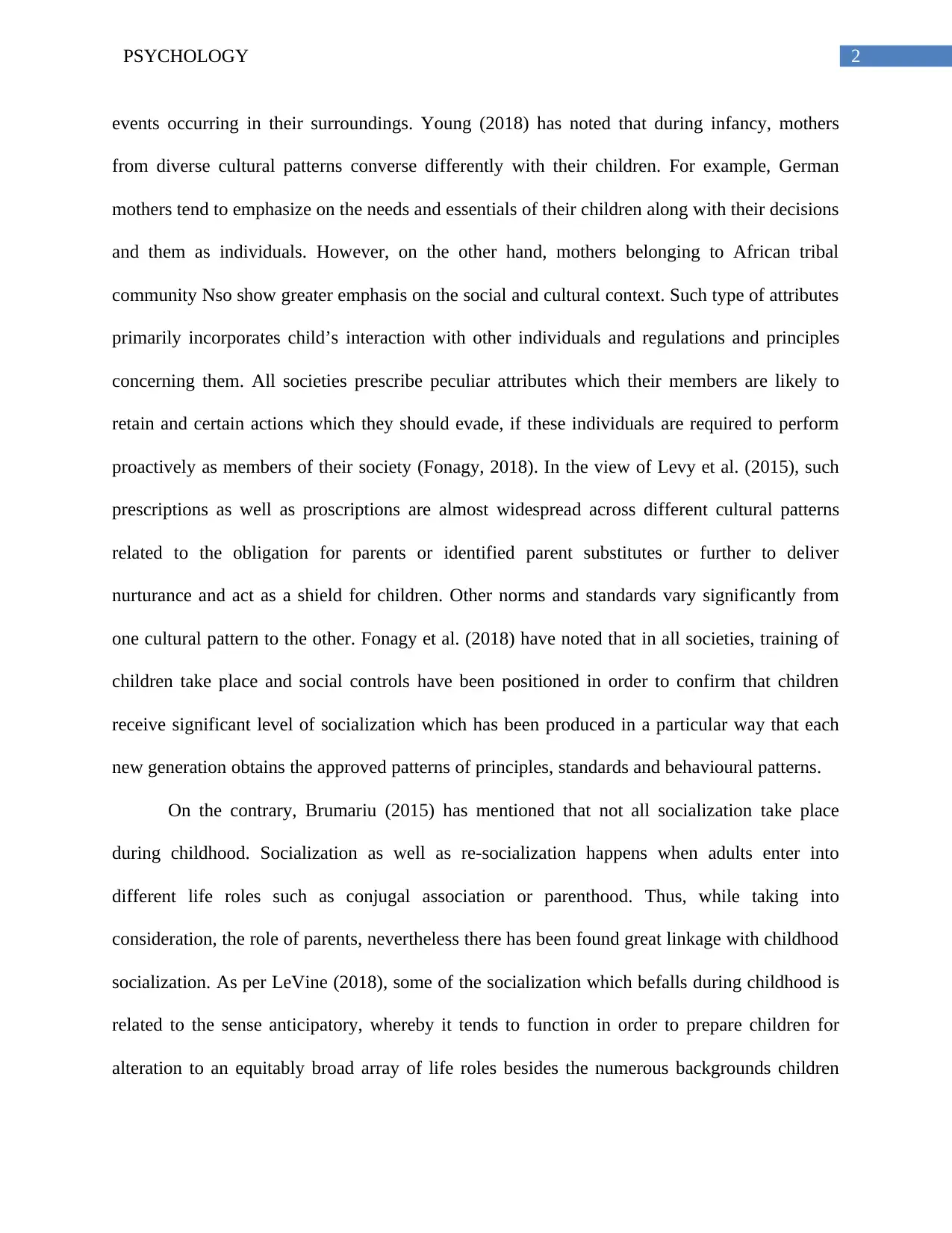
2PSYCHOLOGY
events occurring in their surroundings. Young (2018) has noted that during infancy, mothers
from diverse cultural patterns converse differently with their children. For example, German
mothers tend to emphasize on the needs and essentials of their children along with their decisions
and them as individuals. However, on the other hand, mothers belonging to African tribal
community Nso show greater emphasis on the social and cultural context. Such type of attributes
primarily incorporates child’s interaction with other individuals and regulations and principles
concerning them. All societies prescribe peculiar attributes which their members are likely to
retain and certain actions which they should evade, if these individuals are required to perform
proactively as members of their society (Fonagy, 2018). In the view of Levy et al. (2015), such
prescriptions as well as proscriptions are almost widespread across different cultural patterns
related to the obligation for parents or identified parent substitutes or further to deliver
nurturance and act as a shield for children. Other norms and standards vary significantly from
one cultural pattern to the other. Fonagy et al. (2018) have noted that in all societies, training of
children take place and social controls have been positioned in order to confirm that children
receive significant level of socialization which has been produced in a particular way that each
new generation obtains the approved patterns of principles, standards and behavioural patterns.
On the contrary, Brumariu (2015) has mentioned that not all socialization take place
during childhood. Socialization as well as re-socialization happens when adults enter into
different life roles such as conjugal association or parenthood. Thus, while taking into
consideration, the role of parents, nevertheless there has been found great linkage with childhood
socialization. As per LeVine (2018), some of the socialization which befalls during childhood is
related to the sense anticipatory, whereby it tends to function in order to prepare children for
alteration to an equitably broad array of life roles besides the numerous backgrounds children
events occurring in their surroundings. Young (2018) has noted that during infancy, mothers
from diverse cultural patterns converse differently with their children. For example, German
mothers tend to emphasize on the needs and essentials of their children along with their decisions
and them as individuals. However, on the other hand, mothers belonging to African tribal
community Nso show greater emphasis on the social and cultural context. Such type of attributes
primarily incorporates child’s interaction with other individuals and regulations and principles
concerning them. All societies prescribe peculiar attributes which their members are likely to
retain and certain actions which they should evade, if these individuals are required to perform
proactively as members of their society (Fonagy, 2018). In the view of Levy et al. (2015), such
prescriptions as well as proscriptions are almost widespread across different cultural patterns
related to the obligation for parents or identified parent substitutes or further to deliver
nurturance and act as a shield for children. Other norms and standards vary significantly from
one cultural pattern to the other. Fonagy et al. (2018) have noted that in all societies, training of
children take place and social controls have been positioned in order to confirm that children
receive significant level of socialization which has been produced in a particular way that each
new generation obtains the approved patterns of principles, standards and behavioural patterns.
On the contrary, Brumariu (2015) has mentioned that not all socialization take place
during childhood. Socialization as well as re-socialization happens when adults enter into
different life roles such as conjugal association or parenthood. Thus, while taking into
consideration, the role of parents, nevertheless there has been found great linkage with childhood
socialization. As per LeVine (2018), some of the socialization which befalls during childhood is
related to the sense anticipatory, whereby it tends to function in order to prepare children for
alteration to an equitably broad array of life roles besides the numerous backgrounds children
⊘ This is a preview!⊘
Do you want full access?
Subscribe today to unlock all pages.

Trusted by 1+ million students worldwide
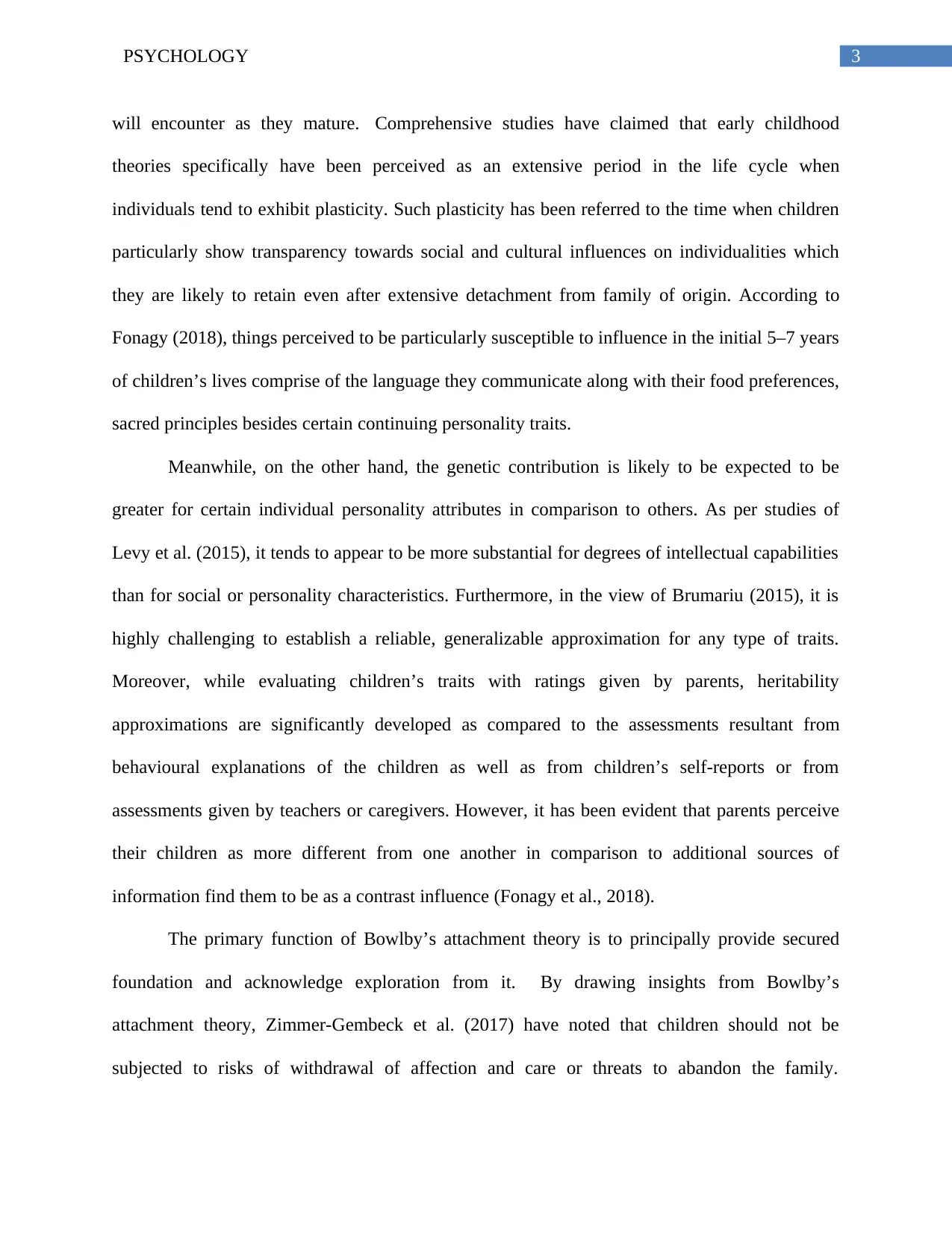
3PSYCHOLOGY
will encounter as they mature. Comprehensive studies have claimed that early childhood
theories specifically have been perceived as an extensive period in the life cycle when
individuals tend to exhibit plasticity. Such plasticity has been referred to the time when children
particularly show transparency towards social and cultural influences on individualities which
they are likely to retain even after extensive detachment from family of origin. According to
Fonagy (2018), things perceived to be particularly susceptible to influence in the initial 5–7 years
of children’s lives comprise of the language they communicate along with their food preferences,
sacred principles besides certain continuing personality traits.
Meanwhile, on the other hand, the genetic contribution is likely to be expected to be
greater for certain individual personality attributes in comparison to others. As per studies of
Levy et al. (2015), it tends to appear to be more substantial for degrees of intellectual capabilities
than for social or personality characteristics. Furthermore, in the view of Brumariu (2015), it is
highly challenging to establish a reliable, generalizable approximation for any type of traits.
Moreover, while evaluating children’s traits with ratings given by parents, heritability
approximations are significantly developed as compared to the assessments resultant from
behavioural explanations of the children as well as from children’s self-reports or from
assessments given by teachers or caregivers. However, it has been evident that parents perceive
their children as more different from one another in comparison to additional sources of
information find them to be as a contrast influence (Fonagy et al., 2018).
The primary function of Bowlby’s attachment theory is to principally provide secured
foundation and acknowledge exploration from it. By drawing insights from Bowlby’s
attachment theory, Zimmer-Gembeck et al. (2017) have noted that children should not be
subjected to risks of withdrawal of affection and care or threats to abandon the family.
will encounter as they mature. Comprehensive studies have claimed that early childhood
theories specifically have been perceived as an extensive period in the life cycle when
individuals tend to exhibit plasticity. Such plasticity has been referred to the time when children
particularly show transparency towards social and cultural influences on individualities which
they are likely to retain even after extensive detachment from family of origin. According to
Fonagy (2018), things perceived to be particularly susceptible to influence in the initial 5–7 years
of children’s lives comprise of the language they communicate along with their food preferences,
sacred principles besides certain continuing personality traits.
Meanwhile, on the other hand, the genetic contribution is likely to be expected to be
greater for certain individual personality attributes in comparison to others. As per studies of
Levy et al. (2015), it tends to appear to be more substantial for degrees of intellectual capabilities
than for social or personality characteristics. Furthermore, in the view of Brumariu (2015), it is
highly challenging to establish a reliable, generalizable approximation for any type of traits.
Moreover, while evaluating children’s traits with ratings given by parents, heritability
approximations are significantly developed as compared to the assessments resultant from
behavioural explanations of the children as well as from children’s self-reports or from
assessments given by teachers or caregivers. However, it has been evident that parents perceive
their children as more different from one another in comparison to additional sources of
information find them to be as a contrast influence (Fonagy et al., 2018).
The primary function of Bowlby’s attachment theory is to principally provide secured
foundation and acknowledge exploration from it. By drawing insights from Bowlby’s
attachment theory, Zimmer-Gembeck et al. (2017) have noted that children should not be
subjected to risks of withdrawal of affection and care or threats to abandon the family.
Paraphrase This Document
Need a fresh take? Get an instant paraphrase of this document with our AI Paraphraser
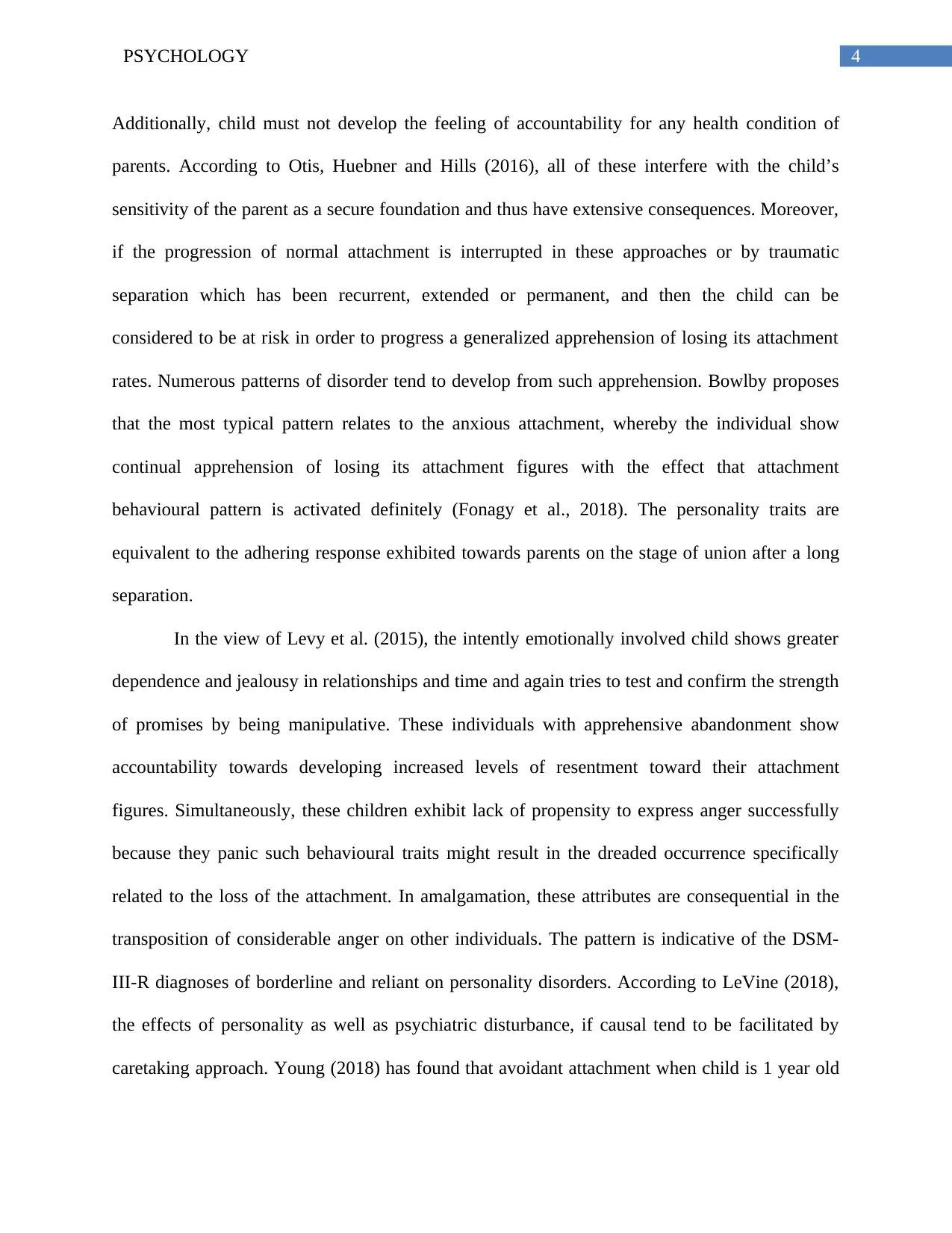
4PSYCHOLOGY
Additionally, child must not develop the feeling of accountability for any health condition of
parents. According to Otis, Huebner and Hills (2016), all of these interfere with the child’s
sensitivity of the parent as a secure foundation and thus have extensive consequences. Moreover,
if the progression of normal attachment is interrupted in these approaches or by traumatic
separation which has been recurrent, extended or permanent, and then the child can be
considered to be at risk in order to progress a generalized apprehension of losing its attachment
rates. Numerous patterns of disorder tend to develop from such apprehension. Bowlby proposes
that the most typical pattern relates to the anxious attachment, whereby the individual show
continual apprehension of losing its attachment figures with the effect that attachment
behavioural pattern is activated definitely (Fonagy et al., 2018). The personality traits are
equivalent to the adhering response exhibited towards parents on the stage of union after a long
separation.
In the view of Levy et al. (2015), the intently emotionally involved child shows greater
dependence and jealousy in relationships and time and again tries to test and confirm the strength
of promises by being manipulative. These individuals with apprehensive abandonment show
accountability towards developing increased levels of resentment toward their attachment
figures. Simultaneously, these children exhibit lack of propensity to express anger successfully
because they panic such behavioural traits might result in the dreaded occurrence specifically
related to the loss of the attachment. In amalgamation, these attributes are consequential in the
transposition of considerable anger on other individuals. The pattern is indicative of the DSM-
III-R diagnoses of borderline and reliant on personality disorders. According to LeVine (2018),
the effects of personality as well as psychiatric disturbance, if causal tend to be facilitated by
caretaking approach. Young (2018) has found that avoidant attachment when child is 1 year old
Additionally, child must not develop the feeling of accountability for any health condition of
parents. According to Otis, Huebner and Hills (2016), all of these interfere with the child’s
sensitivity of the parent as a secure foundation and thus have extensive consequences. Moreover,
if the progression of normal attachment is interrupted in these approaches or by traumatic
separation which has been recurrent, extended or permanent, and then the child can be
considered to be at risk in order to progress a generalized apprehension of losing its attachment
rates. Numerous patterns of disorder tend to develop from such apprehension. Bowlby proposes
that the most typical pattern relates to the anxious attachment, whereby the individual show
continual apprehension of losing its attachment figures with the effect that attachment
behavioural pattern is activated definitely (Fonagy et al., 2018). The personality traits are
equivalent to the adhering response exhibited towards parents on the stage of union after a long
separation.
In the view of Levy et al. (2015), the intently emotionally involved child shows greater
dependence and jealousy in relationships and time and again tries to test and confirm the strength
of promises by being manipulative. These individuals with apprehensive abandonment show
accountability towards developing increased levels of resentment toward their attachment
figures. Simultaneously, these children exhibit lack of propensity to express anger successfully
because they panic such behavioural traits might result in the dreaded occurrence specifically
related to the loss of the attachment. In amalgamation, these attributes are consequential in the
transposition of considerable anger on other individuals. The pattern is indicative of the DSM-
III-R diagnoses of borderline and reliant on personality disorders. According to LeVine (2018),
the effects of personality as well as psychiatric disturbance, if causal tend to be facilitated by
caretaking approach. Young (2018) has found that avoidant attachment when child is 1 year old
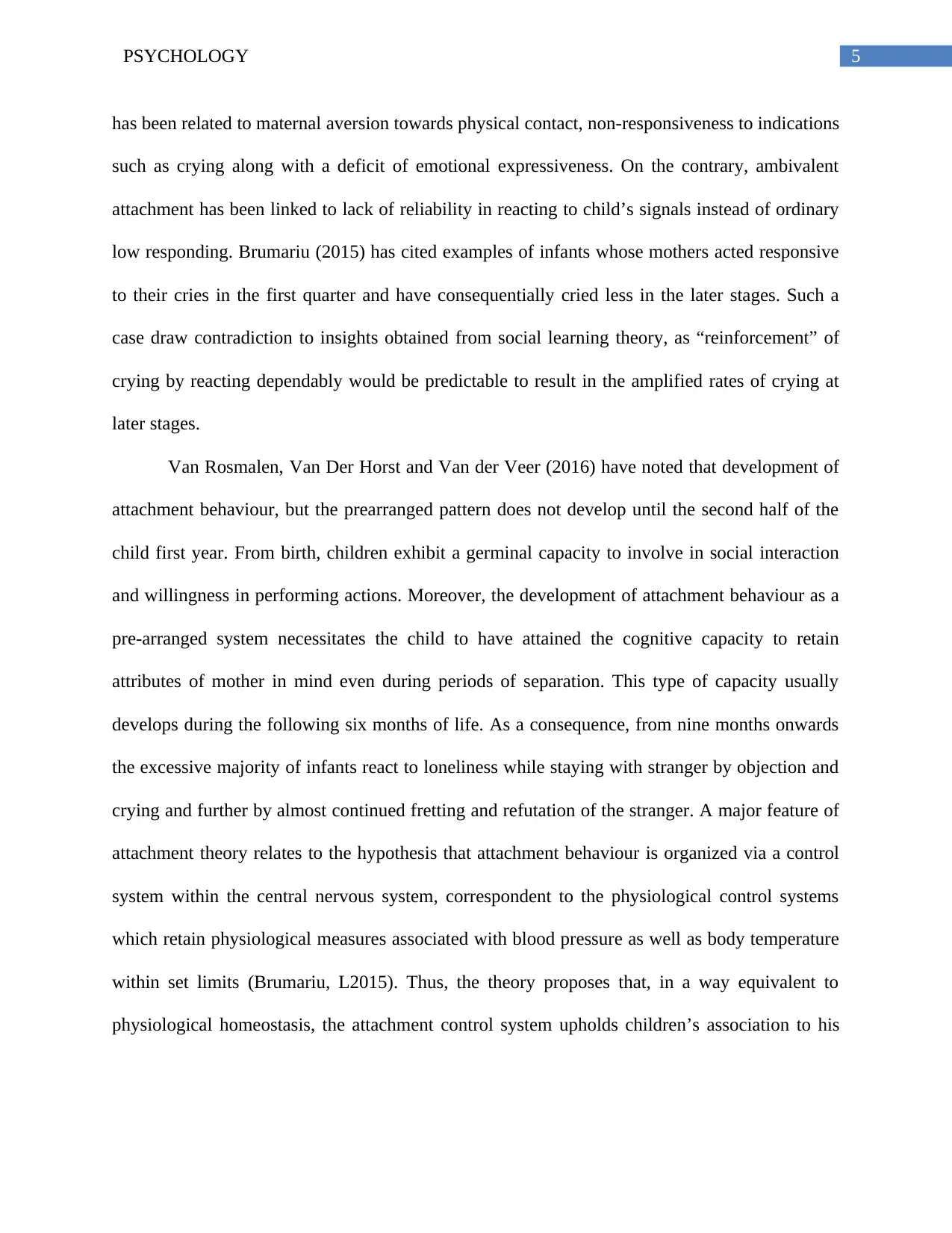
5PSYCHOLOGY
has been related to maternal aversion towards physical contact, non-responsiveness to indications
such as crying along with a deficit of emotional expressiveness. On the contrary, ambivalent
attachment has been linked to lack of reliability in reacting to child’s signals instead of ordinary
low responding. Brumariu (2015) has cited examples of infants whose mothers acted responsive
to their cries in the first quarter and have consequentially cried less in the later stages. Such a
case draw contradiction to insights obtained from social learning theory, as “reinforcement” of
crying by reacting dependably would be predictable to result in the amplified rates of crying at
later stages.
Van Rosmalen, Van Der Horst and Van der Veer (2016) have noted that development of
attachment behaviour, but the prearranged pattern does not develop until the second half of the
child first year. From birth, children exhibit a germinal capacity to involve in social interaction
and willingness in performing actions. Moreover, the development of attachment behaviour as a
pre-arranged system necessitates the child to have attained the cognitive capacity to retain
attributes of mother in mind even during periods of separation. This type of capacity usually
develops during the following six months of life. As a consequence, from nine months onwards
the excessive majority of infants react to loneliness while staying with stranger by objection and
crying and further by almost continued fretting and refutation of the stranger. A major feature of
attachment theory relates to the hypothesis that attachment behaviour is organized via a control
system within the central nervous system, correspondent to the physiological control systems
which retain physiological measures associated with blood pressure as well as body temperature
within set limits (Brumariu, L2015). Thus, the theory proposes that, in a way equivalent to
physiological homeostasis, the attachment control system upholds children’s association to his
has been related to maternal aversion towards physical contact, non-responsiveness to indications
such as crying along with a deficit of emotional expressiveness. On the contrary, ambivalent
attachment has been linked to lack of reliability in reacting to child’s signals instead of ordinary
low responding. Brumariu (2015) has cited examples of infants whose mothers acted responsive
to their cries in the first quarter and have consequentially cried less in the later stages. Such a
case draw contradiction to insights obtained from social learning theory, as “reinforcement” of
crying by reacting dependably would be predictable to result in the amplified rates of crying at
later stages.
Van Rosmalen, Van Der Horst and Van der Veer (2016) have noted that development of
attachment behaviour, but the prearranged pattern does not develop until the second half of the
child first year. From birth, children exhibit a germinal capacity to involve in social interaction
and willingness in performing actions. Moreover, the development of attachment behaviour as a
pre-arranged system necessitates the child to have attained the cognitive capacity to retain
attributes of mother in mind even during periods of separation. This type of capacity usually
develops during the following six months of life. As a consequence, from nine months onwards
the excessive majority of infants react to loneliness while staying with stranger by objection and
crying and further by almost continued fretting and refutation of the stranger. A major feature of
attachment theory relates to the hypothesis that attachment behaviour is organized via a control
system within the central nervous system, correspondent to the physiological control systems
which retain physiological measures associated with blood pressure as well as body temperature
within set limits (Brumariu, L2015). Thus, the theory proposes that, in a way equivalent to
physiological homeostasis, the attachment control system upholds children’s association to his
⊘ This is a preview!⊘
Do you want full access?
Subscribe today to unlock all pages.

Trusted by 1+ million students worldwide
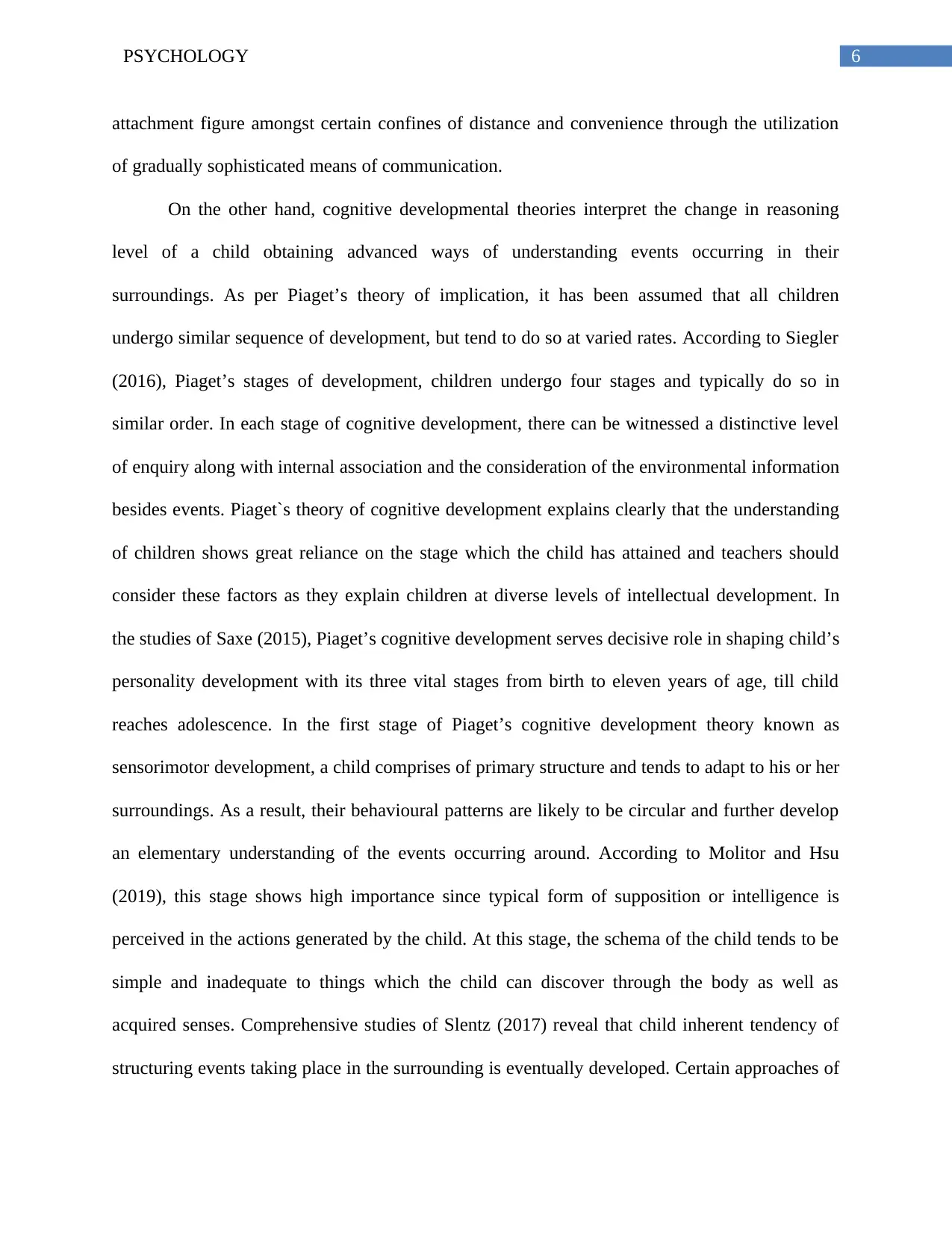
6PSYCHOLOGY
attachment figure amongst certain confines of distance and convenience through the utilization
of gradually sophisticated means of communication.
On the other hand, cognitive developmental theories interpret the change in reasoning
level of a child obtaining advanced ways of understanding events occurring in their
surroundings. As per Piaget’s theory of implication, it has been assumed that all children
undergo similar sequence of development, but tend to do so at varied rates. According to Siegler
(2016), Piaget’s stages of development, children undergo four stages and typically do so in
similar order. In each stage of cognitive development, there can be witnessed a distinctive level
of enquiry along with internal association and the consideration of the environmental information
besides events. Piaget`s theory of cognitive development explains clearly that the understanding
of children shows great reliance on the stage which the child has attained and teachers should
consider these factors as they explain children at diverse levels of intellectual development. In
the studies of Saxe (2015), Piaget’s cognitive development serves decisive role in shaping child’s
personality development with its three vital stages from birth to eleven years of age, till child
reaches adolescence. In the first stage of Piaget’s cognitive development theory known as
sensorimotor development, a child comprises of primary structure and tends to adapt to his or her
surroundings. As a result, their behavioural patterns are likely to be circular and further develop
an elementary understanding of the events occurring around. According to Molitor and Hsu
(2019), this stage shows high importance since typical form of supposition or intelligence is
perceived in the actions generated by the child. At this stage, the schema of the child tends to be
simple and inadequate to things which the child can discover through the body as well as
acquired senses. Comprehensive studies of Slentz (2017) reveal that child inherent tendency of
structuring events taking place in the surrounding is eventually developed. Certain approaches of
attachment figure amongst certain confines of distance and convenience through the utilization
of gradually sophisticated means of communication.
On the other hand, cognitive developmental theories interpret the change in reasoning
level of a child obtaining advanced ways of understanding events occurring in their
surroundings. As per Piaget’s theory of implication, it has been assumed that all children
undergo similar sequence of development, but tend to do so at varied rates. According to Siegler
(2016), Piaget’s stages of development, children undergo four stages and typically do so in
similar order. In each stage of cognitive development, there can be witnessed a distinctive level
of enquiry along with internal association and the consideration of the environmental information
besides events. Piaget`s theory of cognitive development explains clearly that the understanding
of children shows great reliance on the stage which the child has attained and teachers should
consider these factors as they explain children at diverse levels of intellectual development. In
the studies of Saxe (2015), Piaget’s cognitive development serves decisive role in shaping child’s
personality development with its three vital stages from birth to eleven years of age, till child
reaches adolescence. In the first stage of Piaget’s cognitive development theory known as
sensorimotor development, a child comprises of primary structure and tends to adapt to his or her
surroundings. As a result, their behavioural patterns are likely to be circular and further develop
an elementary understanding of the events occurring around. According to Molitor and Hsu
(2019), this stage shows high importance since typical form of supposition or intelligence is
perceived in the actions generated by the child. At this stage, the schema of the child tends to be
simple and inadequate to things which the child can discover through the body as well as
acquired senses. Comprehensive studies of Slentz (2017) reveal that child inherent tendency of
structuring events taking place in the surrounding is eventually developed. Certain approaches of
Paraphrase This Document
Need a fresh take? Get an instant paraphrase of this document with our AI Paraphraser
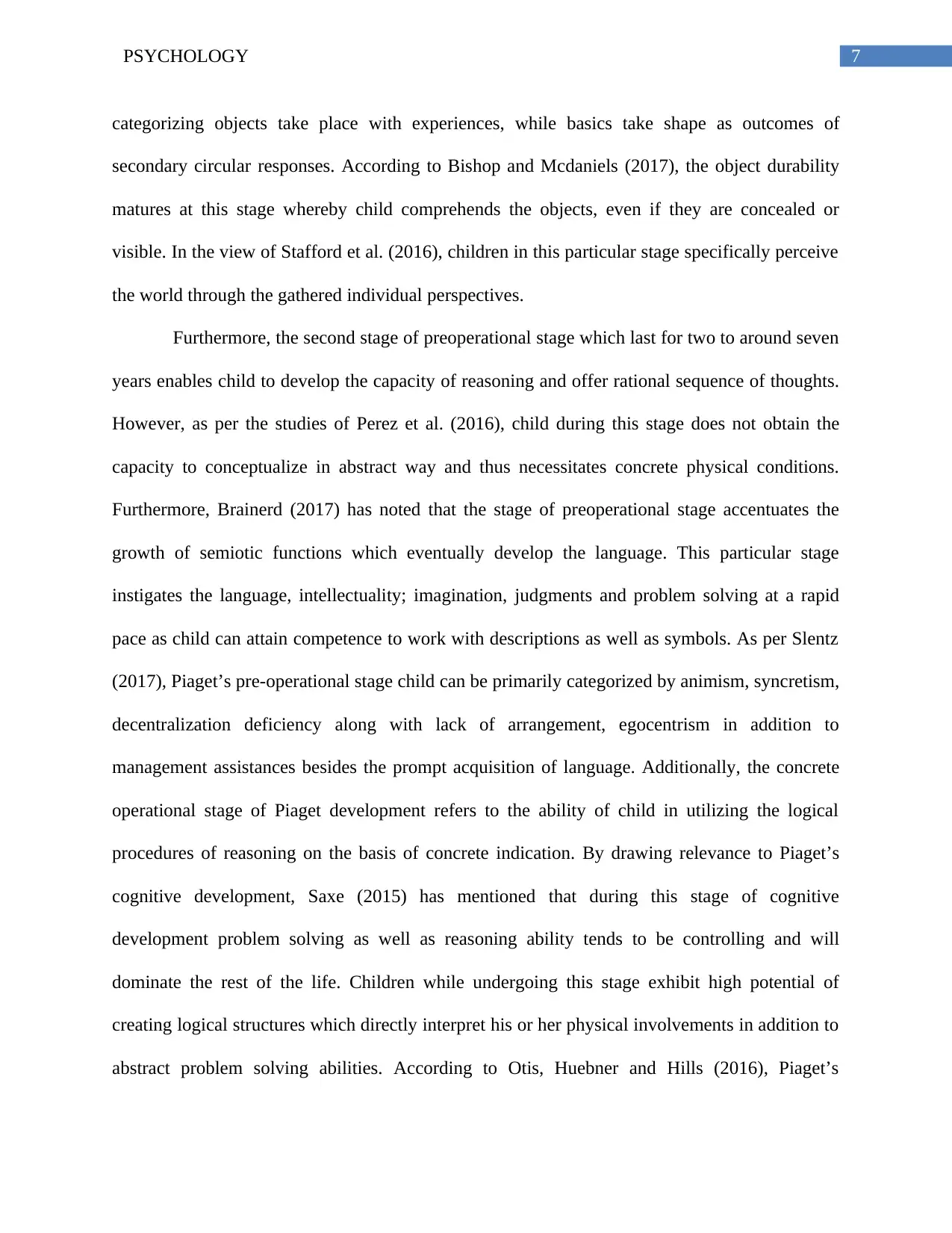
7PSYCHOLOGY
categorizing objects take place with experiences, while basics take shape as outcomes of
secondary circular responses. According to Bishop and Mcdaniels (2017), the object durability
matures at this stage whereby child comprehends the objects, even if they are concealed or
visible. In the view of Stafford et al. (2016), children in this particular stage specifically perceive
the world through the gathered individual perspectives.
Furthermore, the second stage of preoperational stage which last for two to around seven
years enables child to develop the capacity of reasoning and offer rational sequence of thoughts.
However, as per the studies of Perez et al. (2016), child during this stage does not obtain the
capacity to conceptualize in abstract way and thus necessitates concrete physical conditions.
Furthermore, Brainerd (2017) has noted that the stage of preoperational stage accentuates the
growth of semiotic functions which eventually develop the language. This particular stage
instigates the language, intellectuality; imagination, judgments and problem solving at a rapid
pace as child can attain competence to work with descriptions as well as symbols. As per Slentz
(2017), Piaget’s pre-operational stage child can be primarily categorized by animism, syncretism,
decentralization deficiency along with lack of arrangement, egocentrism in addition to
management assistances besides the prompt acquisition of language. Additionally, the concrete
operational stage of Piaget development refers to the ability of child in utilizing the logical
procedures of reasoning on the basis of concrete indication. By drawing relevance to Piaget’s
cognitive development, Saxe (2015) has mentioned that during this stage of cognitive
development problem solving as well as reasoning ability tends to be controlling and will
dominate the rest of the life. Children while undergoing this stage exhibit high potential of
creating logical structures which directly interpret his or her physical involvements in addition to
abstract problem solving abilities. According to Otis, Huebner and Hills (2016), Piaget’s
categorizing objects take place with experiences, while basics take shape as outcomes of
secondary circular responses. According to Bishop and Mcdaniels (2017), the object durability
matures at this stage whereby child comprehends the objects, even if they are concealed or
visible. In the view of Stafford et al. (2016), children in this particular stage specifically perceive
the world through the gathered individual perspectives.
Furthermore, the second stage of preoperational stage which last for two to around seven
years enables child to develop the capacity of reasoning and offer rational sequence of thoughts.
However, as per the studies of Perez et al. (2016), child during this stage does not obtain the
capacity to conceptualize in abstract way and thus necessitates concrete physical conditions.
Furthermore, Brainerd (2017) has noted that the stage of preoperational stage accentuates the
growth of semiotic functions which eventually develop the language. This particular stage
instigates the language, intellectuality; imagination, judgments and problem solving at a rapid
pace as child can attain competence to work with descriptions as well as symbols. As per Slentz
(2017), Piaget’s pre-operational stage child can be primarily categorized by animism, syncretism,
decentralization deficiency along with lack of arrangement, egocentrism in addition to
management assistances besides the prompt acquisition of language. Additionally, the concrete
operational stage of Piaget development refers to the ability of child in utilizing the logical
procedures of reasoning on the basis of concrete indication. By drawing relevance to Piaget’s
cognitive development, Saxe (2015) has mentioned that during this stage of cognitive
development problem solving as well as reasoning ability tends to be controlling and will
dominate the rest of the life. Children while undergoing this stage exhibit high potential of
creating logical structures which directly interpret his or her physical involvements in addition to
abstract problem solving abilities. According to Otis, Huebner and Hills (2016), Piaget’s
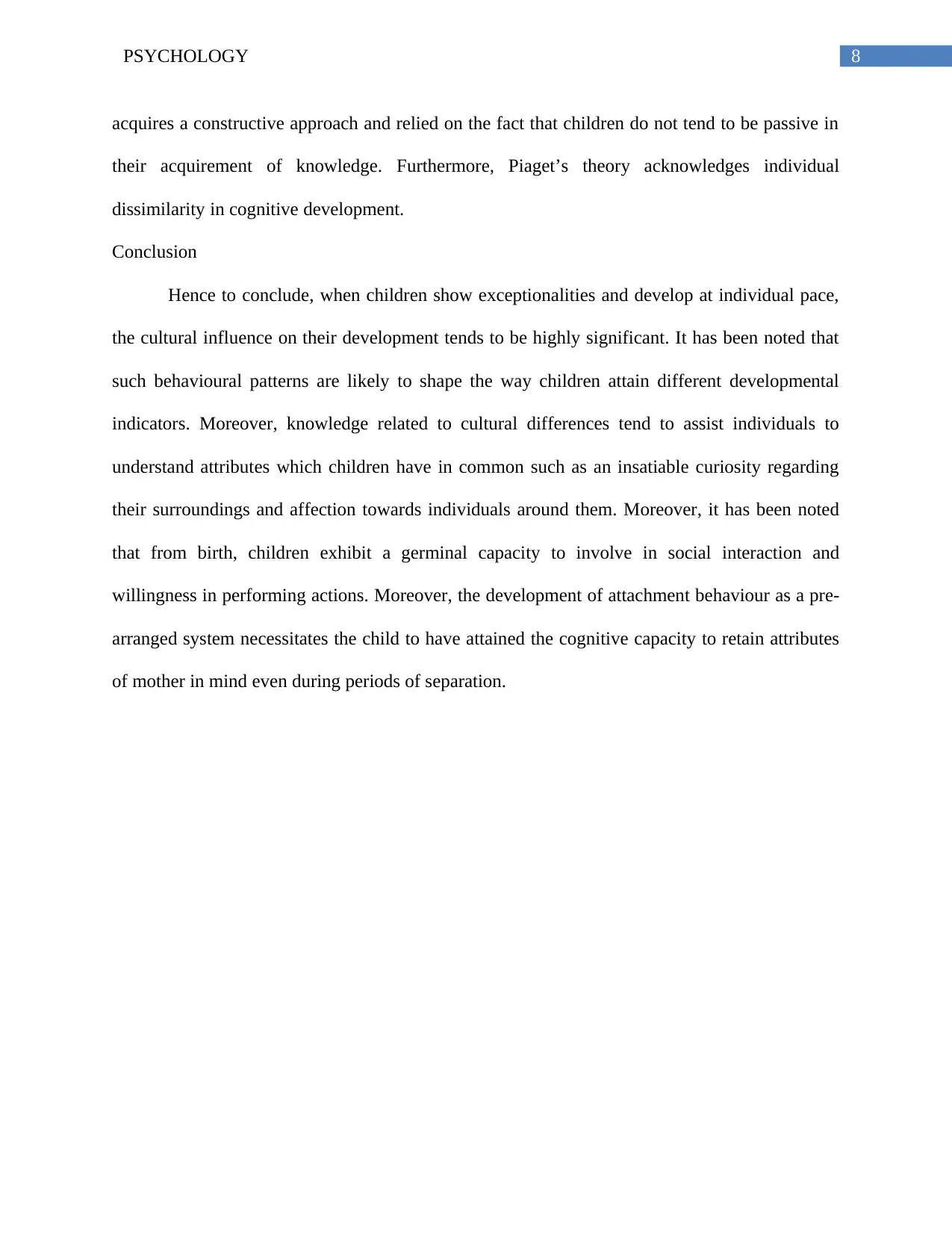
8PSYCHOLOGY
acquires a constructive approach and relied on the fact that children do not tend to be passive in
their acquirement of knowledge. Furthermore, Piaget’s theory acknowledges individual
dissimilarity in cognitive development.
Conclusion
Hence to conclude, when children show exceptionalities and develop at individual pace,
the cultural influence on their development tends to be highly significant. It has been noted that
such behavioural patterns are likely to shape the way children attain different developmental
indicators. Moreover, knowledge related to cultural differences tend to assist individuals to
understand attributes which children have in common such as an insatiable curiosity regarding
their surroundings and affection towards individuals around them. Moreover, it has been noted
that from birth, children exhibit a germinal capacity to involve in social interaction and
willingness in performing actions. Moreover, the development of attachment behaviour as a pre-
arranged system necessitates the child to have attained the cognitive capacity to retain attributes
of mother in mind even during periods of separation.
acquires a constructive approach and relied on the fact that children do not tend to be passive in
their acquirement of knowledge. Furthermore, Piaget’s theory acknowledges individual
dissimilarity in cognitive development.
Conclusion
Hence to conclude, when children show exceptionalities and develop at individual pace,
the cultural influence on their development tends to be highly significant. It has been noted that
such behavioural patterns are likely to shape the way children attain different developmental
indicators. Moreover, knowledge related to cultural differences tend to assist individuals to
understand attributes which children have in common such as an insatiable curiosity regarding
their surroundings and affection towards individuals around them. Moreover, it has been noted
that from birth, children exhibit a germinal capacity to involve in social interaction and
willingness in performing actions. Moreover, the development of attachment behaviour as a pre-
arranged system necessitates the child to have attained the cognitive capacity to retain attributes
of mother in mind even during periods of separation.
⊘ This is a preview!⊘
Do you want full access?
Subscribe today to unlock all pages.

Trusted by 1+ million students worldwide
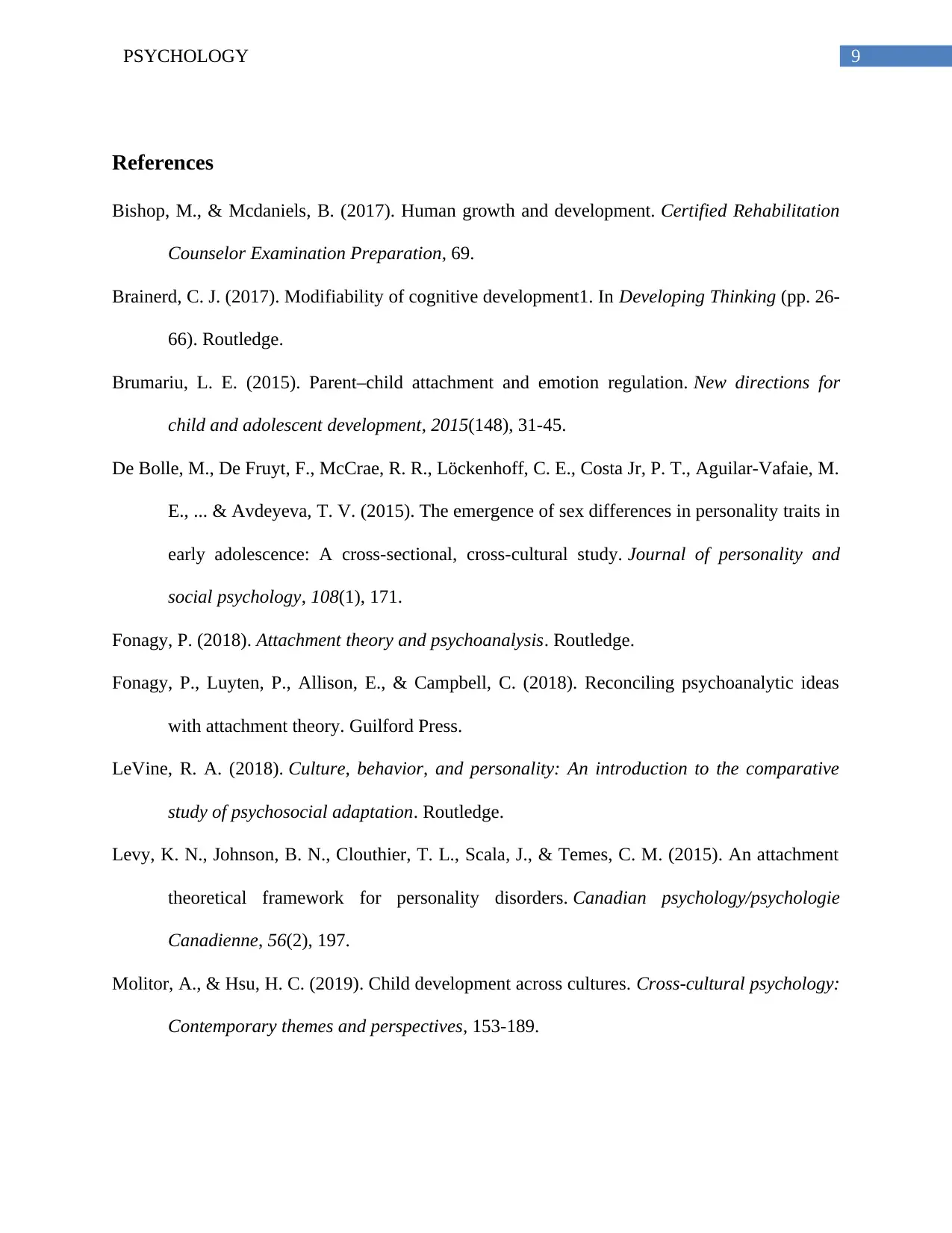
9PSYCHOLOGY
References
Bishop, M., & Mcdaniels, B. (2017). Human growth and development. Certified Rehabilitation
Counselor Examination Preparation, 69.
Brainerd, C. J. (2017). Modifiability of cognitive development1. In Developing Thinking (pp. 26-
66). Routledge.
Brumariu, L. E. (2015). Parent–child attachment and emotion regulation. New directions for
child and adolescent development, 2015(148), 31-45.
De Bolle, M., De Fruyt, F., McCrae, R. R., Löckenhoff, C. E., Costa Jr, P. T., Aguilar-Vafaie, M.
E., ... & Avdeyeva, T. V. (2015). The emergence of sex differences in personality traits in
early adolescence: A cross-sectional, cross-cultural study. Journal of personality and
social psychology, 108(1), 171.
Fonagy, P. (2018). Attachment theory and psychoanalysis. Routledge.
Fonagy, P., Luyten, P., Allison, E., & Campbell, C. (2018). Reconciling psychoanalytic ideas
with attachment theory. Guilford Press.
LeVine, R. A. (2018). Culture, behavior, and personality: An introduction to the comparative
study of psychosocial adaptation. Routledge.
Levy, K. N., Johnson, B. N., Clouthier, T. L., Scala, J., & Temes, C. M. (2015). An attachment
theoretical framework for personality disorders. Canadian psychology/psychologie
Canadienne, 56(2), 197.
Molitor, A., & Hsu, H. C. (2019). Child development across cultures. Cross‐cultural psychology:
Contemporary themes and perspectives, 153-189.
References
Bishop, M., & Mcdaniels, B. (2017). Human growth and development. Certified Rehabilitation
Counselor Examination Preparation, 69.
Brainerd, C. J. (2017). Modifiability of cognitive development1. In Developing Thinking (pp. 26-
66). Routledge.
Brumariu, L. E. (2015). Parent–child attachment and emotion regulation. New directions for
child and adolescent development, 2015(148), 31-45.
De Bolle, M., De Fruyt, F., McCrae, R. R., Löckenhoff, C. E., Costa Jr, P. T., Aguilar-Vafaie, M.
E., ... & Avdeyeva, T. V. (2015). The emergence of sex differences in personality traits in
early adolescence: A cross-sectional, cross-cultural study. Journal of personality and
social psychology, 108(1), 171.
Fonagy, P. (2018). Attachment theory and psychoanalysis. Routledge.
Fonagy, P., Luyten, P., Allison, E., & Campbell, C. (2018). Reconciling psychoanalytic ideas
with attachment theory. Guilford Press.
LeVine, R. A. (2018). Culture, behavior, and personality: An introduction to the comparative
study of psychosocial adaptation. Routledge.
Levy, K. N., Johnson, B. N., Clouthier, T. L., Scala, J., & Temes, C. M. (2015). An attachment
theoretical framework for personality disorders. Canadian psychology/psychologie
Canadienne, 56(2), 197.
Molitor, A., & Hsu, H. C. (2019). Child development across cultures. Cross‐cultural psychology:
Contemporary themes and perspectives, 153-189.
Paraphrase This Document
Need a fresh take? Get an instant paraphrase of this document with our AI Paraphraser
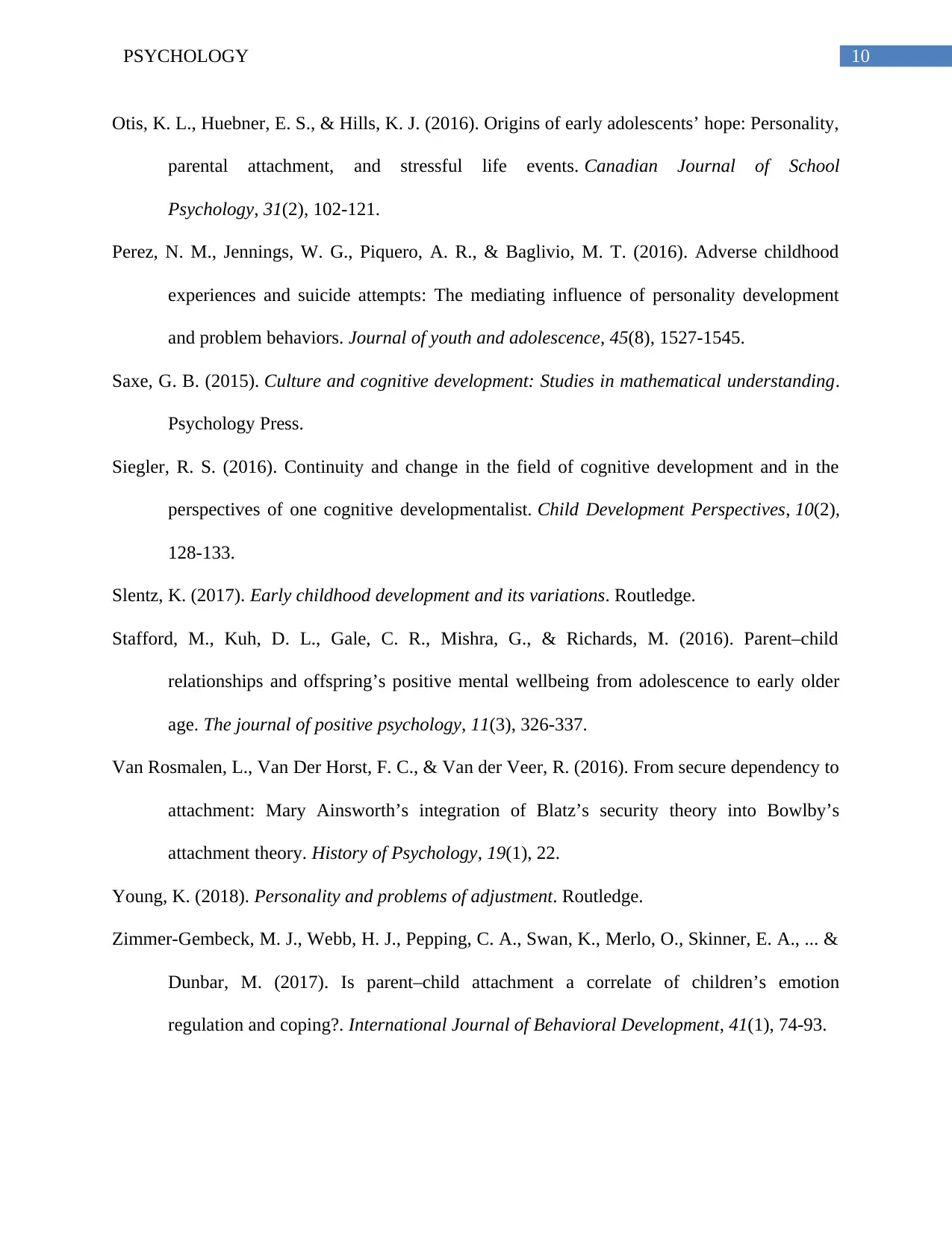
10PSYCHOLOGY
Otis, K. L., Huebner, E. S., & Hills, K. J. (2016). Origins of early adolescents’ hope: Personality,
parental attachment, and stressful life events. Canadian Journal of School
Psychology, 31(2), 102-121.
Perez, N. M., Jennings, W. G., Piquero, A. R., & Baglivio, M. T. (2016). Adverse childhood
experiences and suicide attempts: The mediating influence of personality development
and problem behaviors. Journal of youth and adolescence, 45(8), 1527-1545.
Saxe, G. B. (2015). Culture and cognitive development: Studies in mathematical understanding.
Psychology Press.
Siegler, R. S. (2016). Continuity and change in the field of cognitive development and in the
perspectives of one cognitive developmentalist. Child Development Perspectives, 10(2),
128-133.
Slentz, K. (2017). Early childhood development and its variations. Routledge.
Stafford, M., Kuh, D. L., Gale, C. R., Mishra, G., & Richards, M. (2016). Parent–child
relationships and offspring’s positive mental wellbeing from adolescence to early older
age. The journal of positive psychology, 11(3), 326-337.
Van Rosmalen, L., Van Der Horst, F. C., & Van der Veer, R. (2016). From secure dependency to
attachment: Mary Ainsworth’s integration of Blatz’s security theory into Bowlby’s
attachment theory. History of Psychology, 19(1), 22.
Young, K. (2018). Personality and problems of adjustment. Routledge.
Zimmer-Gembeck, M. J., Webb, H. J., Pepping, C. A., Swan, K., Merlo, O., Skinner, E. A., ... &
Dunbar, M. (2017). Is parent–child attachment a correlate of children’s emotion
regulation and coping?. International Journal of Behavioral Development, 41(1), 74-93.
Otis, K. L., Huebner, E. S., & Hills, K. J. (2016). Origins of early adolescents’ hope: Personality,
parental attachment, and stressful life events. Canadian Journal of School
Psychology, 31(2), 102-121.
Perez, N. M., Jennings, W. G., Piquero, A. R., & Baglivio, M. T. (2016). Adverse childhood
experiences and suicide attempts: The mediating influence of personality development
and problem behaviors. Journal of youth and adolescence, 45(8), 1527-1545.
Saxe, G. B. (2015). Culture and cognitive development: Studies in mathematical understanding.
Psychology Press.
Siegler, R. S. (2016). Continuity and change in the field of cognitive development and in the
perspectives of one cognitive developmentalist. Child Development Perspectives, 10(2),
128-133.
Slentz, K. (2017). Early childhood development and its variations. Routledge.
Stafford, M., Kuh, D. L., Gale, C. R., Mishra, G., & Richards, M. (2016). Parent–child
relationships and offspring’s positive mental wellbeing from adolescence to early older
age. The journal of positive psychology, 11(3), 326-337.
Van Rosmalen, L., Van Der Horst, F. C., & Van der Veer, R. (2016). From secure dependency to
attachment: Mary Ainsworth’s integration of Blatz’s security theory into Bowlby’s
attachment theory. History of Psychology, 19(1), 22.
Young, K. (2018). Personality and problems of adjustment. Routledge.
Zimmer-Gembeck, M. J., Webb, H. J., Pepping, C. A., Swan, K., Merlo, O., Skinner, E. A., ... &
Dunbar, M. (2017). Is parent–child attachment a correlate of children’s emotion
regulation and coping?. International Journal of Behavioral Development, 41(1), 74-93.
1 out of 11
Related Documents
Your All-in-One AI-Powered Toolkit for Academic Success.
+13062052269
info@desklib.com
Available 24*7 on WhatsApp / Email
![[object Object]](/_next/static/media/star-bottom.7253800d.svg)
Unlock your academic potential
Copyright © 2020–2025 A2Z Services. All Rights Reserved. Developed and managed by ZUCOL.





